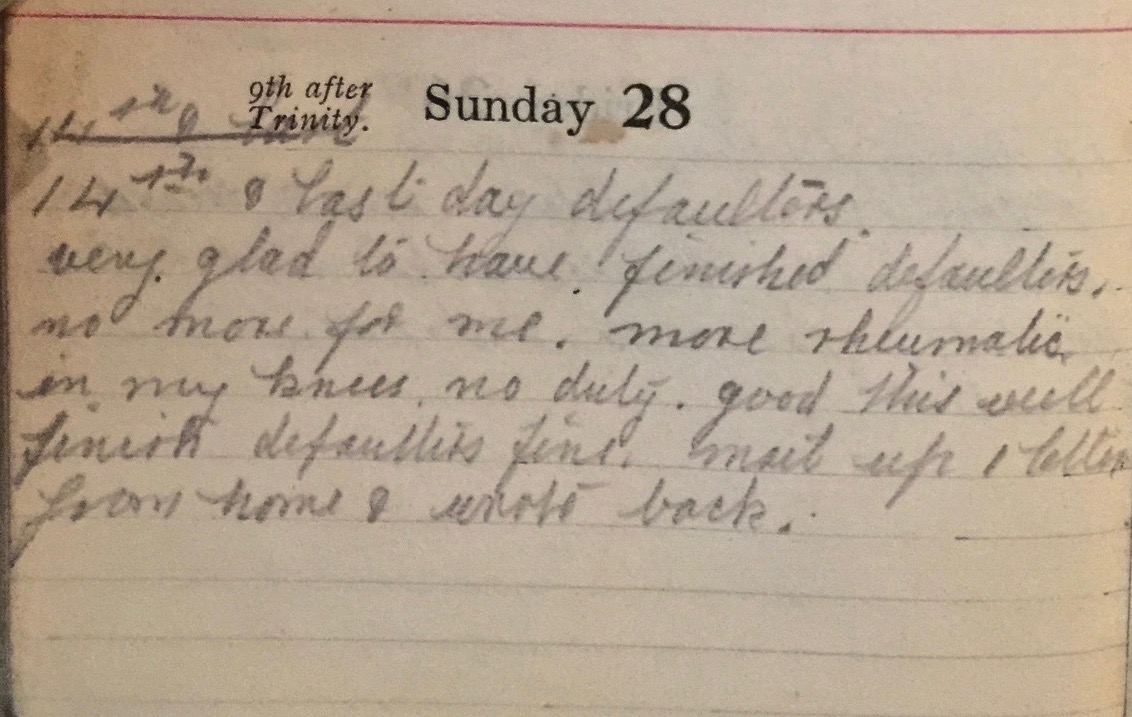Sunday July 28th, 1918
Fourteenth and last day defaulters. Very glad to have finished defaulters – no more for me. More rheumatic in my knees – no duty. Good this will finish defaulters fine. Mail up – one letter from home and wrote back.
Finished Punishment
Frank has now completed his fourteen day punishment for eating unsanctioned bully beef. Because he is still suffering with rheumatics in his knees, he is excused duty – including the extra fatigues. I suppose he got off lightly.
Brigadier’s Instruction
Brigadier General Williams is addressing his officers today. He is laying out his expectations for the routine and discipline of the 199th Brigade.
The hierarchy of officers can be split into two main groups:
General Officers are the top of the pile. They are permanent appointments and, in the British Army during WWI, comprise the ranks of Field Marshall, General, Lieutenant General, Major General and Brigadier General.
Field Officers are junior to a General Officer and can be temporary appointments. In the British Army during WWI the hierarchy of Field Officers comprise Lieutenant Colonel (typically a Battalion Commander), Major, Captain, Lieutenant and Second Lieutenant.
Second Lieutenants or Lieutenants, who serve with a Company of soldiers (~200) are also sometimes referred to as Company Officers.
More information on the structure of the British Army in WWI is here on this website.
Brigadier General

Robert Beatson wrote in the mid-18th century that in Britain and Ireland after 1746 the role of Brigadier General stopped being a General Officer and became a temporary or local appointment.† At some point before WWI, this changed again and the rank of Brigadier General once again became a General Officer. This will continue until after WWI when the rank will be abolished in 1921. The position will be then reintroduced into the hierarchy in 1928 but called simply ‘Brigadier’. As such, it will be classified as a Field Officer rank.³
There is some debate about why this position was reclassified after the war. One opinion is that the Brigadier General rank was abolished in 1921 because there were a lot of young Brigadier Generals in these permanent General Officer appointments and the burden of their pensions was too great.‡
The image shows the British Army’s rank insignia for Brigadier Generals (1920-22). * Before and during the early days of WWI rank insignia was traditionally worn on the cuffs of the officer’s jacket This policy was revised in 1917 to allow it to be worn on either epaulets or cuffs. Displayed on epaulets, it made officers’ ranks less obvious to the enemy. Insignia on cuffs will be abandoned officially in 1920.
13th (Service) Battalion War Diary – 28th July 1918 – Haudricourt, France
Sunday. Church Parade Church of England 11:00hrs RC 09:00hrs. Brigadier lectured to all officers of Brigade 12:00 hrs on the general principles of discipline and routine expected in Brigade. Battalion association football team beat 5th Royal Irish Fusiliers 1-0.
References & Further Reading
¹ Field Officer on Wikipedia
² General Officer on Wikipedia
³ Brigadier General on Wikipedia
º Brigadier General on Britannica
† Beatson, Robert (1788). A Political Index to the Histories of Great Britain and Ireland: Or, A Complete Register of the Hereditary Honours, Public Offices, and Persons in Office, from the Earliest Periods to the Present Time. G. G. J. & J. Robinson. p. 387.
‡ Thread on Quora
* British & Commonwealth Army Rank Insignia of Brigadier General (1920-22). Image from Wikicommons under Creative Commons licence


